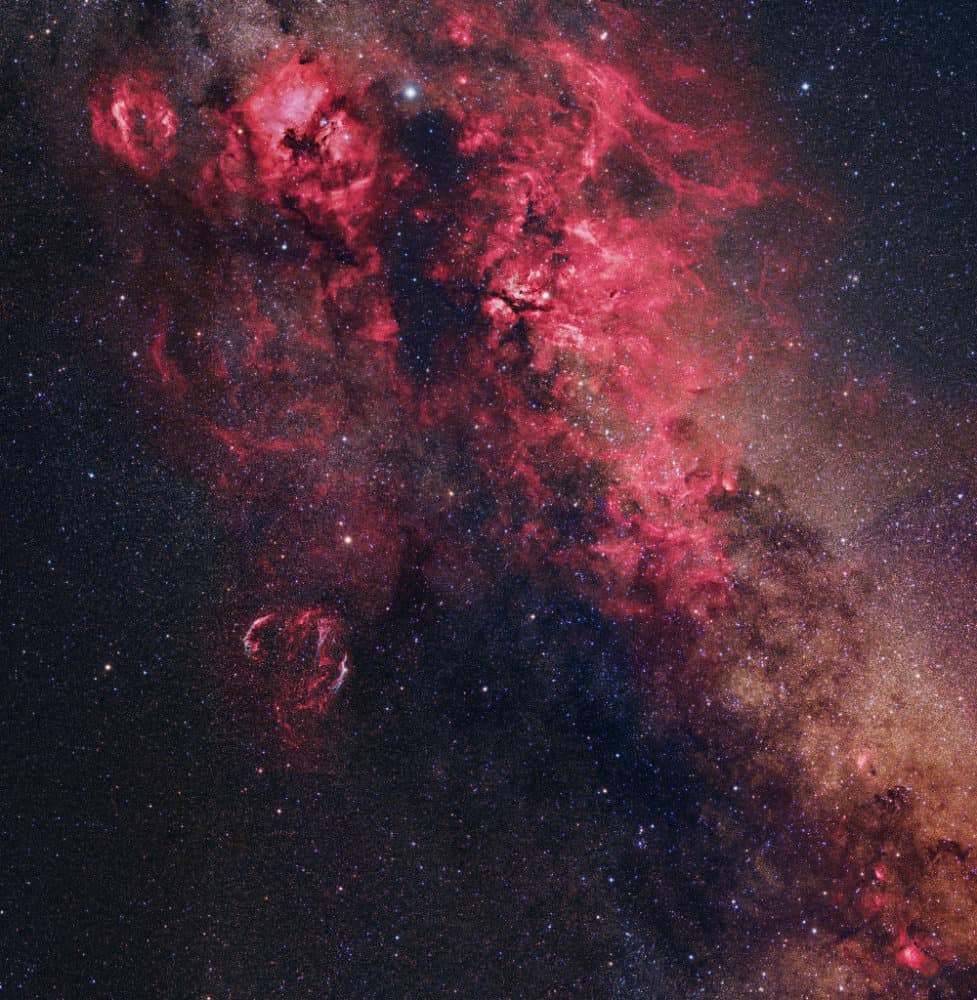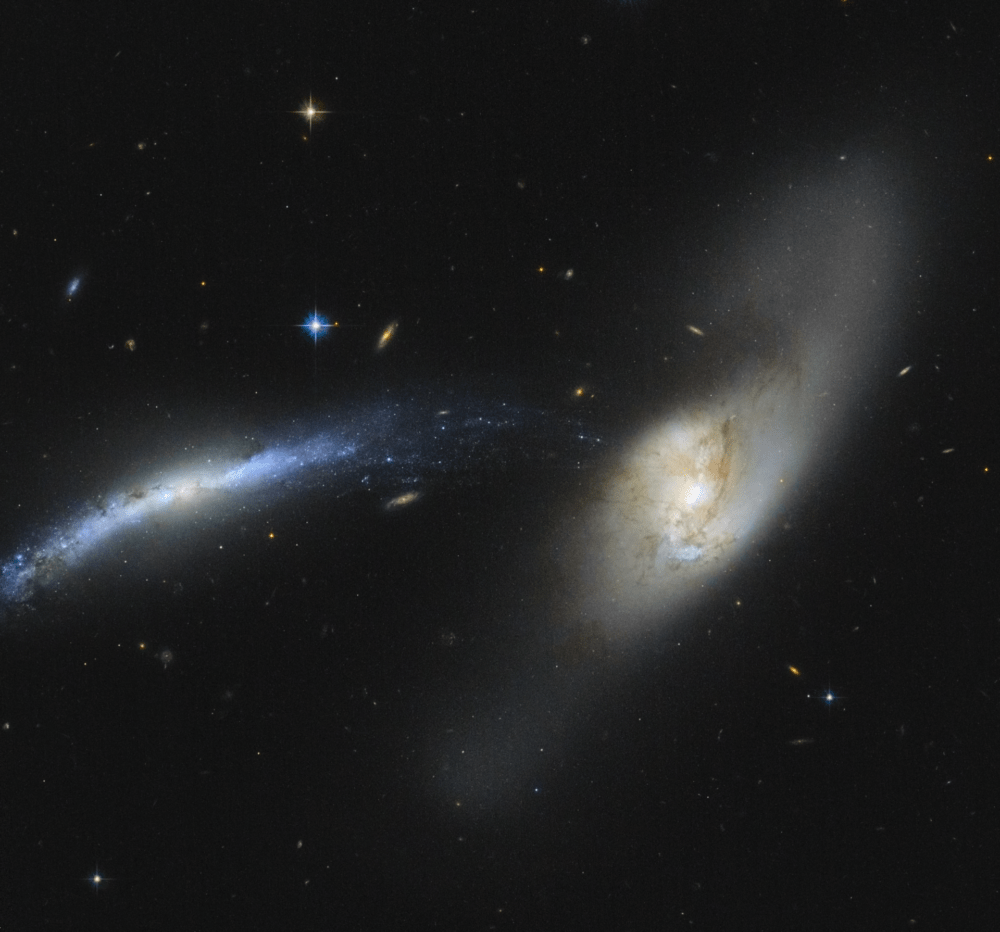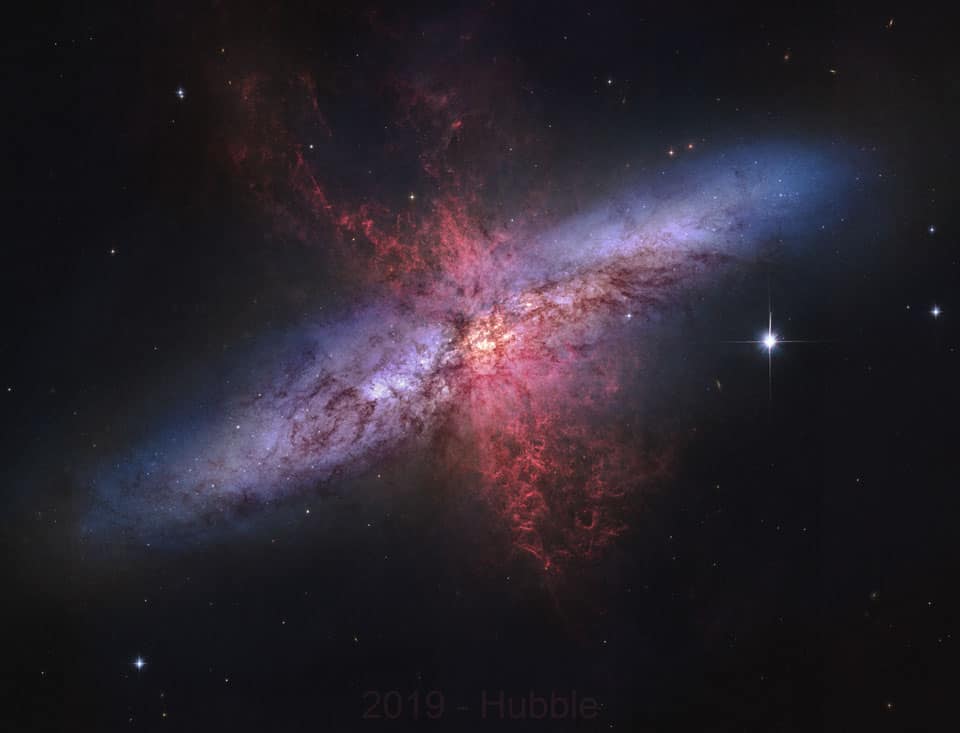Blog
Flamenco Fridays with Zambra.
Zambra (Spanish pronunciation: [ˈθambɾa]), (from Andalusi Arabic Zamra, originally from classical Arabic Zamr) is a style of Flamenco dance, typical of the Gypsies of the provinces of Granada and Almeria (Andalusia, Spain).
It is believed that the Zambra is a continuation of earlier Morisco styles of dance. It became typical during wedding ceremonies, although nowadays it is particularly commonly danced for tourists in the caves of Sacromonte (Granada) and in the caves of Almería. In modern times, it has been espoused by flamenco dancers Carmen Amaya, Lola Flores, and Puela Lunaris. It is danced barefoot with finger cymbals; the blouse is tied under the bust and the skirt is very tight around the hips, then flares out and has a ruffle at the end.
more...
The plane of our Milky Way Galaxy near the northern end of the Great Rift and the constellation Cygnus the Swan. Composed with three different telescopes and about 90 hours of image data the widefield mosaic spans an impressive 24 degrees across the sky. Alpha star of Cygnus, bright, hot, supergiant Deneb lies near top center. Crowded with stars and luminous gas clouds Cygnus is also home to the dark, obscuring Northern Coal Sack Nebula, extending from Deneb toward the center of the view. The reddish glow of star forming regions NGC 7000, the North America Nebula and IC 5070, the Pelican Nebula, are just left of Deneb. The Veil Nebula is a standout below and left of center. A supernova remnant, the Veil is some 1,400 light years away, but many other nebulae and star clusters are identifiable throughout the cosmic scene. Of course, Deneb itself is also known to northern hemisphere skygazers for its place in two asterisms — marking the top of the Northern Cross and a vertex of the Summer Triangle.
Deneb /ˈdɛnɛb/ is a first-magnitude star in the constellation of Cygnus, the swan. Deneb is one of the vertices of the asterism known as the Summer Triangle and the “head” of the Northern Cross. It is the brightest star in Cygnus and the 19th brightest star in the night sky, with an average apparent magnitude of 1.25. A blue-white supergiant, Deneb rivals Rigel as the most luminous first magnitude star. However its distance, and hence luminosity, is poorly known; its luminosity is somewhere between 55,000 and 196,000 times that of the Sun. Its Bayer designation is α Cygni which is Latinised to Alpha Cygni, abbreviated to Alpha Cyg or α Cyg.
Deneb’s adopted distance from the Earth is around 802 parsecs (2,620 ly)
more...Donald Johnson Ellis (July 25, 1934 – December 17, 1978) was an American jazz trumpeter, drummer, composer, and bandleader. He is best known for his extensive musical experimentation, particularly in the area of time signatures. Later in his life he worked as a film composer, contributing a score to 1971’s The French Connection and 1973’s The Seven-Ups. Ellis was born in Los Angeles, California, on July 25, 1934. His father was a Methodist minister and his mother a church organist. He attended West High School in Minneapolis, MN. After attending a Tommy Dorsey Big Band concert, he first became interested in jazz. Other early inspirations were Louis Armstrong and Dizzy Gillespie. He graduated from Boston University in 1956 with a music composition degree.
Cornelius “Johnny” Hodges (July 25, 1907 – May 11, 1970) was an American alto saxophonist, best known for solo work with Duke Ellington‘s big band. He played lead alto in the saxophone section for many years. Hodges was also featured on soprano saxophone, but refused to play soprano after 1946. He is considered one of the definitive alto saxophone players of the big band era (along with Benny Carter).
After beginning his career as a teenager in Boston, Hodges began to travel to New York and played with Lloyd Scott, Sidney Bechet, Luckey Robertsand Chick Webb. When Ellington wanted to expand his band in 1928, Ellington’s clarinet player Barney Bigard recommended Hodges. His playing became one of the identifying voices of the Ellington orchestra. From 1951 to 1955, Hodges left the Duke to lead his own band, but returned shortly before Ellington’s triumphant return to prominence – the orchestra’s performance at the 1956 Newport Jazz Festival.
Hodges was born in the Cambridgeport neighborhood of Cambridge, Massachusetts, to John H. Hodges and Katie Swan Hodges, both originally from Virginia. After moving for a short period of time to North Cambridge, the family moved to Hammond Street in the South End of Boston, where he grew up with baritone saxophonist Harry Carney, and saxophonists Charlie Holmes and Howard E. Johnson.
https://www.youtube.com/watch?v=15pTu_OzAG4
more...Semmangudi Radhakrishna Srinivasa Iyer (25 July 1908 – 31 October 2003) was a Carnatic vocalist. He was the youngest recipient of the Sangeetha Kalanidhi awarded by the Music Academy in 1947 and has received many awards including Padma Bhushan and Padma Vibhushanfrom the Government of India, Sangeet Natak Academy award (1953), Isai Perarignar from Government of Tamil Nadu and Kalidas Samman from Government of Madhya Pradesh. He was affectionately addressed as “Semmangudi Maama” (Semmangudi Uncle) by his disciples. He, along with his contemporaries G.N. Balasubramaniam and Madurai Mani Iyer, are referred to as the 20th century male trinity of Carnatic music. He was also considered the “Pitamaha” or the grand sire of modern Carnatic Music. He was conferred with an honorary doctorate by University of Kerala in 1979.
He was born in Tirukkodikaval, Tanjore district as the third son of Radhakrishna Iyer and Dharmasamvardhini Ammal. He lived with his maternal uncle Tirukkodikaval Krishna Iyer, a violin maestro, until the age of four and after his death, moved back to his parents’ home in Semmangudi, Tiruvarur District. At the age of eight he started learning music from his cousin Semmangudi Narayanaswamy Iyer. This was followed by some rigorous training under Thiruvadaimaruthur Sakharama Rao, a famous Gottuvadhyam exponent, an event considered by Semmangudi as a turning point in his life. This was followed by another training stint with Narayanaswamy Iyer, during which time he learnt a lot of varnams and keerthanams. Then he had a musical apprenticeship with Maharajapuram Viswanatha Iyer. In 1926, he performed his first music recital at Kumbakonam.[6] In 1927 gave a concert in the Madras session of Indian National Congress, another event considered by Semmangudy as a turning point in his life, as it catapulted him into the big league of vidwans at that time. He was known for producing soulful music, highly creative and yet very orthodox, despite a recalcitrant voice.
more...NGC 2798 is a barred spiral galaxy in the constellation Lynx. NGC 2798 and NGC 2799 are listed under the Arp Catalogue as Arp 283 and noted as an “interacting galaxy pair”. Distance 79 M light years.
more...
Charles McPherson (born July 24, 1939) is an American jazz alto saxophonist born in Joplin, Missouri, and raised in Detroit, Michigan, who worked intermittently with Charles Mingus from 1960 to 1974, and as a performer leading his own groups.
McPherson also was commissioned to help record ensemble renditions of pieces from Charlie Parker on the 1988 soundtrack for the film Bird.
more...Billy Taylor (July 24, 1921 – December 28, 2010) was an American jazz pianist, composer, broadcaster and educator. He was the Robert L. Jones Distinguished Professor of Music at East Carolina University in Greenville, and from 1994 was the artistic director for jazz at the John F. Kennedy Center for the Performing Arts in Washington, D.C.
A jazz activist, Taylor sat on the Honorary Founders Board of The Jazz Foundation of America, an organisation he started in 1989, with Ann Ruckert, Herb Storfer and Phoebe Jacobs, to save the homes and the lives of America’s elderly jazz and blues musicians, later including musicians who survived Hurricane Katrina. Taylor was also a jazz educator, who lectured in colleges, served on panels and travelled worldwide as a jazz ambassador. Critic Leonard Featheronce said, “It is almost indisputable that Dr. Billy Taylor is the world’s foremost spokesman for jazz.” Taylor was born in Greenville, North Carolina, but moved to Washington, D.C., when he was five years old. He grew up in a musical family and learned to play different instruments as a child, including guitar, drums and saxophone. He was most successful at the piano, and had classical piano lessons with Henry Grant, who had educated Duke Ellington a generation earlier. Taylor made his first professional appearance playing keyboard at the age of 13 and was paid one dollar.
Taylor moved to New York City after graduation and started playing piano professionally from 1944, first with Ben Webster‘s Quartet on New York’s 52nd Street. The same night he joined Webster’s Quartet, he met Art Tatum, who became his mentor. Among the other musicians Taylor worked with was Machito and his mambo band, from whom he developed a love for Latin music. After an eight-month tour with the Don Redman Orchestra in Europe, Taylor stayed there with his wife, Theodora, and in Paris and the Netherlands. Taylor returned to New York later that year and cooperated with Bob Wyatt and Sylvia Syms at the Royal Roost jazz club and Billie Holiday in a successful show called Holiday on Broadway. A year later, he became the house pianist at Birdland and performed with Charlie Parker, J.J. Johnson, Stan Getz, Dizzy Gillespie and Miles Davis. Taylor played at Birdland longer than any other pianist in the history of the club.[6] In 1949, Taylor published his first book, a textbook about bebop piano styles.
https://www.youtube.com/watch?v=AfyHYijQczk
https://www.youtube.com/watch?v=Yjs1oEFOKVE
more...New Orleans sensation Art Neville keyboardist/composer/vocalist left planet Earth!
https://www.musicradar.com/news/new-orleans-funk-legend-art-neville-dies-aged-81?fbclid=IwAR3TgNdyV3l5Kyc3SboOL2gFCxSj_ZM6hKZ_Txx896FHnwC4eMwyxjEU55A
Here is Art Neville at age 16 with the Hawkettes!
more...M82, as this starburst galaxy is also known, was stirred up by a recent pass near large spiral galaxy M81. This doesn’t fully explain the source of the red-glowing outwardly expanding gas and dust, however. Evidence indicates that this gas and dust is being driven out by the combined emerging particle winds of many stars, together creating a galactic superwind. The dust particles are thought to originate in M82’s interstellar medium and are actually similar in size to particles in cigar smoke. The featured photographic mosaic highlights a specific color of red light strongly emitted by ionizedhydrogen gas, showing detailed filaments of this gas and dust. The filaments extend for over 10,000 light years. The 12-million light-year distant Cigar Galaxy is the brightest galaxy in the sky in infrared light, and can be seen in visible light with a small telescope towards the constellation of the Great Bear (Ursa Major).
more...Alison Maria Krauss (born July 23, 1971) is an American bluegrass–country singer and musician. She entered the music industry at an early age, winning local contests by the age of 10 and recording for the first time at 14. She signed with Rounder Records in 1985 and released her first solo album in 1987. She was invited to join the band with which she still performs, Alison Krauss and Union Station, and later released her first album with them as a group in 1989.
She has released fourteen albums, appeared on numerous soundtracks, and helped renew interest in bluegrass music in the United States. Her soundtrack performances have led to further popularity, including the O Brother, Where Art Thou? soundtrack, an album also credited with raising American interest in bluegrass, and the Cold Mountain soundtrack, which led to her performance at the 2004 Academy Awards.
As of 2018, she has won 27 Grammy Awards from 42 nominations, ranking her third behind Quincy Jones and classical conductor Georg Solti for most Grammy Award wins. She is the most awarded singer and the most awarded female artist in Grammy history.
At the time of her first, the 1991 Grammy Awards, she was the second-youngest winner (currently tied as the ninth-youngest). Alison Maria Krauss was born in Decatur, Illinois, to Fred and Louise Krauss. Her father was a German immigrant who came to the United States in 1952 and taught his native language. Her mother, of German and Italian descent, is the daughter of artists. Her older brother, Viktor, is also a musician. Krauss grew up in the college town of Champaign, home to the University of Illinois at Urbana–Champaign where she lived from 1971 to around 1990. She began studying classical violin at age 5 but soon switched to bluegrass. Krauss said she first became involved with music because “[my] mother tried to find interesting things for me to do” and “wanted to get me involved in music, in addition to art and sports”.
Steve Lacy (July 23, 1934 – June 4, 2004), born Steven Norman Lackritz in New York City, was an American jazz saxophonist and composer recognized as one of the important players of soprano saxophone. Coming to prominence in the 1950s as a progressive dixieland musician, Lacy went on to a long and prolific career. He worked extensively in experimental jazz and to a lesser extent in free improvisation, but Lacy’s music was typically melodic and tightly-structured. Lacy also became a highly distinctive composer, with compositions often built out of little more than a single questioning phrase, repeated several times.
The music of Thelonious Monk became a permanent part of Lacy’s repertoire after a stint in the pianist’s band, with Monk’s songs appearing on virtually every Lacy album and concert program; Lacy often partnered with trombonist Roswell Rudd in exploring Monk’s work. Beyond Monk, Lacy performed the work of jazz composers such as Charles Mingus, Duke Ellington and Herbie Nichols; unlike many jazz musicians he rarely played standard popular or show tunes.
Lacy began his career at sixteen playing Dixieland music with much older musicians such as Henry “Red” Allen, Pee Wee Russell, George “Pops” Foster and Zutty Singleton and then with Kansas City jazz players like Buck Clayton, Dicky Wells, and Jimmy Rushing. He then became involved with the avant-garde, performing on Jazz Advance (1956), the debut album of Cecil Taylor,[2]:55 and appearing with Taylor’s groundbreaking quartet at the 1957 Newport Jazz Festival; he also made a notable appearance on an early Gil Evans album. His most enduring relationship, however, was with the music of Thelonious Monk: he recorded the first album to feature only Monk compositions (Reflections, Prestige, 1958) and briefly played in Monk’s band in 1960[3]:241 and later on Monk’s Big Band and Quartet in Concert album (Columbia, 1963).
more...William Thomas “Champion Jack” Dupree (July 23, 1909 or July 4, 1910 – January 21, 1992) was an American blues and boogie-woogie pianist and singer. His nickname was derived from his early career as a boxer. Dupree was a New Orleans blues and boogie-woogie pianist, a barrelhouse “professor”. His father was from the Belgian Congo and his mother was part African American and Cherokee. His birth date has been given as July 4, July 10, and July 23, 1908, 1909, or 1910; the researchers Bob Eagle and Eric LeBlanc give July 4, 1910.
He was orphaned at the age of eight and was sent to the Colored Waifs Home in New Orleans, an institution for orphaned or delinquent boys (about the same time, Louis Armstrong was also sent there as a child, after being arrested as a “dangerous and suspicious character”). Dupree taught himself to play the piano there and later apprenticed with Tuts Washington and Willie Hall, whom he called his father and from whom he learned “Junker’s Blues“. He was also a “spy boy” for the Yellow Pocahontas tribe of the Mardi Gras Indians. He soon began playing in barrelhouses and other drinking establishments.
He began a life of travelling, living in Chicago, where he worked with Georgia Tom, and in Indianapolis, Indiana, where he met Scrapper Blackwell and Leroy Carr. He also worked as a cook. In Detroit, after Joe Louis encouraged him to become a boxer, he fought 107 bouts, winning Golden Gloves and other championships and picking up the nickname Champion Jack, which he used the rest of his life.
He returned to Chicago at the age of 30 and joined a circle of recording artists, including Big Bill Broonzy and Tampa Red, who introduced him to the record producer Lester Melrose. Many of Dupree’s songs were later credited to Melrose as composer, and Melrose claimed publishing rights to them.
Dupree’s career was interrupted by military service in World War II. He was a cook in the United States Navy and was held by the Japanese for two years as a prisoner of war.
After the war, his biggest commercial success was “Walkin’ the Blues”, which he recorded as a duet with Teddy McRae. This led to several national tours and eventually a European tour. In 1959 he played an unofficial (and unpaid) duo gig with Alexis Korner at the London School of Economics.
https://www.youtube.com/watch?v=F9OVRxMeP14
more...https://www.youtube.com/watch?v=Iv8ESka0Oo8
more...More Posts
- World Music Vladimir Cauchemar & alyona alyona
- Daily Roots Fatman Riddim Section
- Cosmos IC 1848
- Phineas Newborn Jr.
- Leo Wright
- Cecil Payne
- Clark Terry
- World Music Ganger
- Daily Roots The Conquerors
- Cosmos Dark Horse & Rho Ophiuchi
- Lucky Peterson
- Majida el Roumi
- Ben Tucker
- Sonny Greer
- World Music Tellef Kvifte
- Daily Roots DEB Music Players
- Cosmos IC 1396
- Dickey Betts
- Alex Acuna
- Tony Williams


